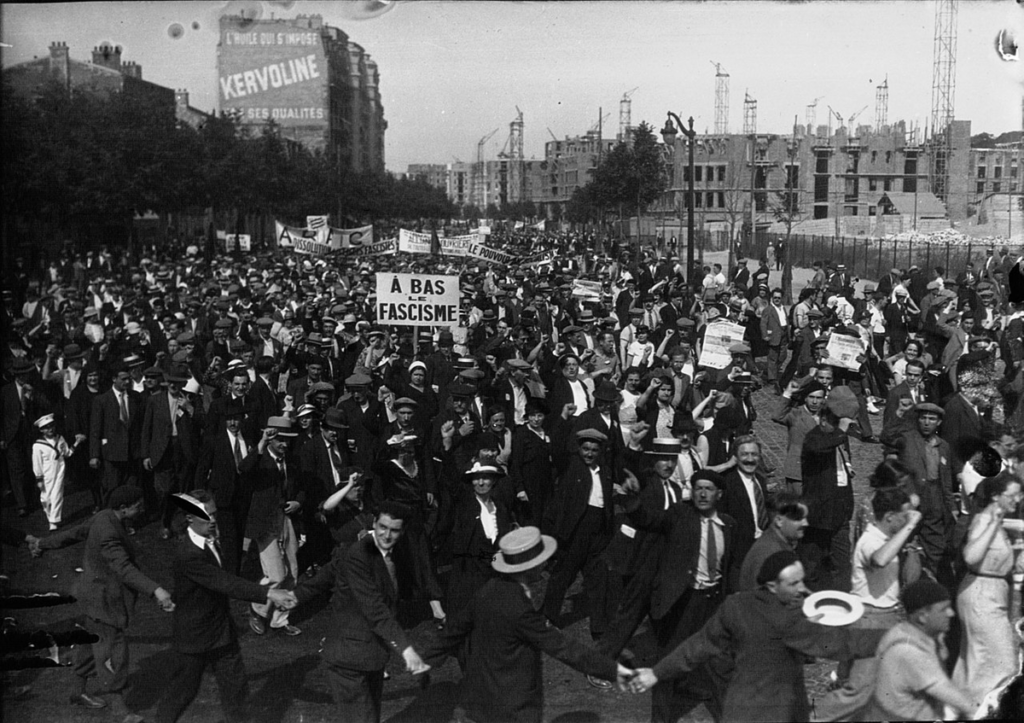“It is not enough to possess the sword, one must give it an edge,” wrote Leon Trotsky in 1922. “It is not enough to give the sword an edge, one must know how to wield it.”
These words are found in “Report on the Question of French Communism,” in which Trotsky was working out a detailed conception of the united front in materials he prepared for the Communist International. His context then was specifically the role of communists in France. But he laid the theoretical groundwork for understanding the difference between a “united front” based on the mobilization of the working class independent of the ruling class and its political parties, the class enemy, and one based on an alliance with elements of the ruling class. The latter kind of alliance came to be known as the “popular front” (or “people’s front”), and in every instance throughout working-class history, it has resulted in betrayal and defeat.
What Is the United Front?
Trotsky was discussing these questions in a context in which revolutionary mobilization was on the agenda, and in which the question was posed whether the working class could wrest power away from the bourgeoisie. His text covers, among other things, how a revolutionary organization that is smaller than other working-class parties (such as those of the social democrats) can gain the leadership of a revolutionary movement. But beyond these discussions, what Trotsky spells out is critically important for how the working class must organize generally to defend its interests.
Today, such considerations are on the agenda in the United States because murderous right-wing terrorism has arisen, a movement that is increasingly targeting — directly and violently — people of color, members of the working class more generally, and the organizations of our class. To confront this threat, many are advocating that we join forces with progressive elements in the Democratic Party, one of twin parties of U.S. capitalism, or even with the incoming Biden administration. Such an alliance is not what is meant by the united front.
In the face of clashes with the Right the working class needs “unity in action [and] in resisting the onslaught of capitalism,” as well as “unity in taking the offensive against it.” It is a revolutionary organization’s responsibility to take up that struggle for unity, within the context of class independence.
The united front is about providing the working class with the strength that comes from unity of action as it wages its struggles against the rulers. That unity is based on developing specific agreements for action with other forces within the workers’ movement, broadly defined, without allying with the enemy. It does not hide differences but strives to find areas where the necessary tasks can be undertaken in a coordinated manner, to make the proverbial fist out of the disparate fingers and thus create strength.
The united part of this conception does not mean a retreat from the disagreements “on fundamental questions of the working-class movement.” It means, rather, seeking agreement “in all those cases where the masses that follow them are ready to engage in joint struggle together with the masses that follow us.” The united front compels “the reformists … to a lesser or greater degree … to become an instrument of this struggle.”
For the reformist parties and trade unions, the united front puts the onus on them to join or stand in the way. “Apart from all other considerations,” Trotsky wrote, “we are … interested in dragging the reformists from their asylums and placing them alongside ourselves before the eyes of the struggling masses.”
Through the united front, not only is the struggle strengthened, but the revolutionaries — struggling alongside activists who are unconvinced that revolutionary politics is necessary — are engaged and can be won to the perspective of going further, to overthrow capitalism. They do this as participants in the struggle, not as critics from the sidelines.
“Any party which mechanically counterposes itself to this need of the working class for unity in action,” writes Trotsky, “will unfailingly be condemned in the minds of the workers.” The task is to build a united front, with “organizational avenues” for “joint, coordinated action” — again, a front that is independent of the class enemy but that decidedly engages the “reformist organization, whether party or trade union,” and even their leaders. That engagement is both part of the strategy to win and an opportunity to break the working class away from its reformist tendencies and those reformist leaders who strive “toward conciliation with the bourgeoisie” because they “dread the revolutionary potential of the mass movement; their beloved arena is the parliamentary tribune, the trade-union bureaux, the arbitration boards, the ministerial antechambers.” And it counters the “centrists” on the Left who claim to be revolutionary but who continually “vacillate” between revolutionary class independence and those reformists.
A Life-and-Death Issue
In early-1920s France, the “groupings” Trotsky was seeking to bring together in a united front included the Socialist Party, the very reformists of the Second International with whom the communists had broken to create a new Communist International; the syndicalists organized in the French trade union movement; and the broader trade union confederations that organized the bulk of the French working class.
A dozen years later, again in France, the question facing the working class was not a revolutionary upsurge but the necessity of mounting a life-and-death struggle against the rise of fascism. In late 1935, Trotsky’s conception of the united front confronted a new “coalition of the proletariat with the imperialist bourgeoisie,” as Trotsky described the “people’s front” — in other words, the very alliance with the class enemy he had warned against in 1922.
The idea had come from the bureaucratic caste that controlled the Soviet Union and its leader, Joseph Stalin. It was developed to defend that caste’s interests from threats both internal and external — but not the threats you might immediately imagine. Stalin feared nothing more than proletarian revolution in other countries of the world, which would challenge him and his band of counterrevolutionary thugs who had solidified their grasp over the Soviet Union and its revolution of 1917. It became the prevailing approach by those who followed Stalin’s ideas — even well beyond his death. It was the codification of abandoning class independence and putting the working class firmly in league with its class enemy.
In France, the “privileged position” in that alliance was given over to the so-called Radical Party, the front’s main bourgeois organization. Workers were relegated to propping up the bourgeois members of the coalition.
The greatest danger in France lies in the fact that the revolutionary energy of the masses will be dissipated in spurts … and give way to apathy. Only conscious traitors or hopeless muddle-heads are capable of thinking that in the present situation it is possible to hold the masses immobilized up to the moment when they will be blessed from above by the government of the People’s Front. Strikes, protests, street clashes, direct uprisings are absolutely inevitable in the present situation. The task of the proletarian party consists not in checking and paralyzing these movements but in unifying them and investing them with the greatest possible force. …
The situation can be saved only by aiding the struggling masses to create a new apparatus, in the process of the struggle itself, which meets the requirements of the moment.
That is the task of building the united front, independent of the class enemy. In France at the time, this was embodied in the concept of “Committees of Action” — important “as the only means of breaking the anti-revolutionary opposition of party and trade-union apparatus” (emphasis in the original).
In a recent article, I discussed the meaning of the terms “fascism” and “fascist” and reviewed Trotsky’s call in December 1931 “For a Worker’s United Front against Fascism” in Germany. In that piece, he articulates the perspective of mass mobilization — a joint struggle by the entire working class, through its parties and organizations, to destroy the fascists and even prepare the working class for a direct struggle for power — that includes, if necessary, taking up arms for mass self-defense. According to this perspective, fascism is a war unleashed by the bourgeoisie at a moment when it sees crushing the working class and its organizations as the last hope for preserving capitalist rule. For this reason, it becomes decisive to maintain the critical independence from the class enemy of a united front — in direct contradistinction to the popular front, which is an alliance with the class enemy.
Trotsky’s 1935 article on France elaborates this point. “Such tasks as the creation of workers’ militia, the arming of the workers, the preparation of a general strike,” he writes, “will remain on paper if the struggling masses themselves, through their authoritative organs, do not occupy themselves with these tasks” (emphasis in the original).
The Popular Front’s Litany of Defeat
From the 1930s to today, the popular front approach has proved itself to be not only counterrevolutionary but also deadly. In the period from 1934 to 1939, when the political alliance subordinated the interests of the working class to the bourgeoisie and its capitalist political parties, it helped facilitate fascism’s solidification and expansion of power.
The strategy was adopted in Spain at the beginning of 1936 as an electoral coalition among ostensibly revolutionary organizations and supporters of a Spanish republic organized in bourgeois parties. It was Stalin’s Comintern that pushed for a coalition with anyone, including the class enemy, that declared its opposition to fascism. And thus the hopes of the Spanish workers and peasants were subordinated to the bourgeoisie.
The Popular Front (the actual name of the electoral coalition) won the 1936 election but failed to prepare the working class to defend itself. That summer, the generals instigated a coup d’état and sparked the Spanish Civil War. Class collaboration stymied the workers’ movement in the fight, and the Communist Party — seeking to shore up its alliances beyond Spain, especially its pact with Hitler aimed at preventing a Nazi attack on the Soviet Union — eventually chose the bourgeoisie over providing material aid to Spanish workers.
In May 1936 in France, the Popular Front (also the electoral coalition’s name) won the legislative elections and formed a government that was first headed by Léon Blum, the leader of the social democratic party known then as the SFIO (Section française de l’Internationale ouvrière, French Section of the Workers’ International) and today as the Socialist Party. Almost immediately, the French workers’ movement launched a general strike to win the social reforms that it expected a popular front government would grant. And to be sure, some reforms were won — including large wage increases and the 40-hour work week.
But the situation in Europe, the persistence of the global Depression, the rise of fascism, and the growing threat of war posed a solution for the working class that was antithetical to the popular front: the overthrow of capitalism. Things were exacerbated by high unemployment and runaway inflation. The ruling class was desperate to supercharge its arms industry for the coming war. Everything the working class had won stood in the way.
How could revolution be accomplished if the working class was organized in an alliance with part of the capitalist class? It is not a rhetorical question.
After World War II, the popular front approach continued as the Stalinists led workers into alliances with the bourgeoisies in France and Italy — so-called “Liberation” governments, to tamp down revolutionary upsurges by workers. These alliances with the capitalists also put the workers’ movement in cahoots with bourgeoisies bound and determined to crush the growing anti-colonial struggles in Africa, Asia, and Latin America.
Fifty years ago, in September 1970, the people of Chile elected a popular front government that ended up leading to disaster. Salvador Allende won a narrow plurality in the presidential election. He was the candidate of Unidad Popular (Popular Unity), yet another alliance between the Stalinist and social democratic parties with various other forces on the Left and parties that represented the liberal wing of the Chilean bourgeoisie. In an example of history’s morbid sense of humor, these included a Radical Party (just like in France).
Allende’s election as president was secured when another bourgeois party, the Christian Democrats, decided to vote in favor of his candidacy when the election was thrown to the Chilean National Congress.
In power, the Popular Unity government of Allende pursued “la vía chilena al socialismo” (the Chilean way to socialism), nationalizing some large-scale industries and redistributing some land. Big landowners balked. Financiers began to agitate against the government. The Catholic Church expressed its opposition to educational reforms that lessened its role in the country’s schools. As the Christian Democrats and other bourgeois components of the popular front abandoned ship, the situation for the Chilean working class grew more and more tenuous.
On September 11, 1973, Allende was overthrown in a bloody military coup led by General Augusto Pinochet, backed by the U.S. government and largely organized and funded by the CIA. The coupists butchered some 30,000 workers and peasants, particularly targeting leftists of all stripes. Close to 100,000 people were forced to flee to other countries, where for years they were hunted down and murdered by Pinochet’s secret police as part of a terror campaign organized by the CIA — Operation Condor. In the meanwhile, the Chilean junta imposed brutal economic austerity that decimated the standard of living of the Chilean people as the country’s ruling class enriched itself at their expense.
Allende’s popular front in Chile had sown the seeds of its own destruction at the hands of the generals, who, working on behalf of the ruling class, launched a coup that paved the way for the bloody defeat of the working class. To win confirmation in the Congress, Unidad Popular succumbed to the demands of the class enemy that would ensure that the institutions of capitalist rule were maintained and that bourgeois order would persist. One of the most important of these demands made it easy for the military to slaughter the people: a prohibition on the creation of “private” (that is, workers’) militias and a firm agreement that no police or military officers would be appointed who had not been trained in the bourgeoisie’s established academies.
Allende’s cabinet put the most right-leaning, class-collaborationist of the alliance’s “Left” forces, the social democrats, in charge of internal security. The liberal Radical Party got the ministry of national defense. The die was cast.
The political regime inherited from that coup is at the very foundation of the uprisings that erupted in Chile in the latter part of 2019.
Lessons for Today
The popular front strategy not only failed to stop fascism in the 1930s. It has proved, time and again, to be a path to defeat of the working class. Collaboration with the bourgeoisie is no different than inviting the fox into the hen house. And as the Chilean experience shows, the ruling class will put the shackles on advancing revolution at every turn. In that case, it demanded the country’s constitution be amended to prevent the workers from arming themselves to defend their gains and their lives.
Today, we confront a growing far-right insurgency that is targeting people of color, immigrants, the entire working class. As capitalism’s economic and social crisis worsens, being fueled by the pandemic, this force may become a direct tool of the bourgeoisie’s efforts to maintain its hold on power and its ability to continue to exploit us. Will we fight that with our own power, or will we follow the deadly example of the popular front?
History makes clear which choice guarantees defeat and which offers us a chance to survive and win. Whether we are confronting a rising right-wing threat, even fascism, or we are fighting the attacks that are sure to come from the Biden administration, our class independence will be decisive. The strategy and tactics that the working class chooses today and tomorrow have costs.











